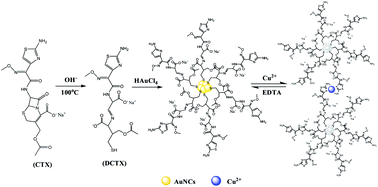Fabrication of cefotaxime sodium-functionalized gold nanoclusters for the detection of copper ions in Chinese herbal medicines†
Abstract
Antibiotic-based gold nanoclusters (AuNCs) are a good sensing platform for specific recognition; however, the related studies are few. Herein, a simple and facile strategy was proposed for the fabrication of bright blue fluorescent AuNCs through the degradation product (DCTX) of cefotaxime sodium that induced the reduction of HAuCl4. Various analytical techniques were applied to characterize the prepared AuNCs@DCTX. AuNCs@DCTX exhibited a strong emission peak centered at 420 nm and a quantum yield of 11.8%. Furthermore, an aggregation-induced fluorescence quenching mode endowed the AuNCs@DCTX probe with good specificity and sensitivity for Cu2+ detection. The proposed probe had a linear range of 0.01–40 μM, a precision with a relative standard deviation of 1.2% (n = 8), and a detection limit of 8 nM (signal/noise = 3). Interestingly, the probe could be reused through switching the “off” and “on” states by the addition of Cu2+ and EDTA. The practicality of the sensing platform was investigated for the determination of Cu2+ in four Chinese herbal medicines (CHMs), and the results were in accordance with those obtained by the FAAS method. This study has provided an alternate way for the fabrication of thiolate-protected AuNCs for sensing applications.



 Please wait while we load your content...
Please wait while we load your content...